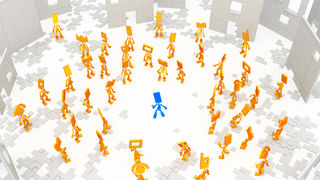Anxiety
Socially Anxious? Beware Where You Look
New research shows that social anxiety makes people focus on negative faces.
Posted April 11, 2016

It was eight o'clock on a quiet evening when Julia received the dreaded text. "We're at usual hangout. Meet up?" She stared at the invitation on her smartphone, her stomach tightening into knots at the very idea of meeting up with friends for a "chill evening of fun". What is wrong with me, she wondered?
Across town, Dave battled his rising dread as he walked down the hall toward the conference room. Through the glass doors, he could see his boss and coworkers munching bagels and sipping coffee before settling down to the required morning staff meeting. As much as he knew how influential these meetings were to his advancement in the firm, he still wished he could avoid them.
Julia and Dave suffer from a common but debilitating disorder called social anxiety disorder.
Social anxiety disorder is characterized by dysfunctional levels of anxiety in response to circumstances that carry the possibility of social evaluation. The anxiety experienced by these individuals is more than simple "butterflies" in the stomach or nervousness. It is intense dread of social encounters.
A growing body of evidence indicates that selective attention to negative social information plays an important role in developing and maintaining social anxiety disorder. The question is whether people who suffer from the disorder preferentially focus on negative social information or whether they have trouble disengaging from it. Do they, for example, preferentially focus on angry faces in a group or do they find it difficult to avoid looking at them? A recent study published in Psychological Science investigated this question.
The researchers used a standard split-display attention task that goes like this:
1. Cue attention: The participants look at a screen and a rectangle appears on either the right or left half of the screen, indicating where to focus attention. One second later, a line appears in the rectangle for about a tenth of a second.
2. Show faces: Two faces appear on the screen, one that has an emotionally neutral expression and one that has a negative expression (anger or disgust). In this study, there were short trials and long trials. On short trials, the faces remained on the screen for half a second; on long trials, they remained on the screen for a full second.
3. Display the probe and measure reaction time: The faces disappear, and then a line appears on the screen on either the left or right side. The participant's task is to decide as quickly as possible whether or not that line is oriented the same as the first one they saw. In this study, the lines had the same orientation (both vertical or both horizontal) on half of the trials, and on the other half, the lines had different orientations (one was vertical and the other was horizontal).
Now here is where the task gets interesting: Imagine first that no faces are shown. Then the speed with which participants respond to the probe should depend on where they are cued to look. The fastest reaction times should occur when people are cued to look at the side of the screen where the probe will later be shown. If instead the probe appears on the opposite side of the screen, they have to shift their attention to that side in order to make a decision, which slows down reaction time.
Now imagine attention is cued to one side of the screen, and the negative face appears on the opposite side of the screen. This should make no difference; the only thing that should matter is where they were initially cued to look. But suppose people are quicker to respond to the probe if it appears on the side of the screen where the negative face appeared. This means the person must have been looking at the negative face. This is called attentional engagement: The negative face engages their attention, and their reaction time is faster when the probe appears on that side rather than the other side.
Now imagine the negative face appears on the same side that the person is cued to look. Again, the location of the negative face should make no difference. The only thing that should matter is whether or not people are initially cued to look where the test probe will appear later. But suppose instead reaction time is considerably slower when the probe appears on the side of the screen where the neutral face appeared. This means that the person had trouble disengaging attention from the negative face. This is called attentional disengagement: The person has to disengage attention from the negative face (and the original cue) in order to respond to the probe.
The participants in the study were 88 first year psychology students. Half where chosen as participants because they scored in the upper range of a social anxiety test. The other half were chosen because they scored very low on the test (meaning they had very little social anxiety.) Each participant saw 256 trials of the task.
The researchers found that high socially anxious participants showed a significantly higher attentional engagement bias than did the low socially anxious participants, but there was no significant difference between high and low socially anxious participants on our measure of disengagement bias. The difference in engagement also only showed up at the shorter duration (half a second).
These results give a "bad news, good news, bad news" picture of social anxiety. The bad news is that they indicate people who suffer from social anxiety are more likely to zero in on negative social stimuli (like angry faces) than people who are more comfortable in social encounters. This is sometimes referred to as attentional vigilance for negative social information. The good news is that they don't necessarily fixate on the negative stimuli. Instead, their ability to disengage is unimpaired, and this can happen in less than a second.
But bad news still enters the picture: A habitual bias for registering negative stimuli in social encounters can lead to some serious psychological turmoil. Those who suffer from social anxiety disorder frequently experience difficulties in interpersonal relationships. This impacts their performance at school and on the job, leading to a tendency to be underemployed. Unchecked, social anxiety disorder increases the risk of developing mood dysfunction (such as depression ) and of suicide. For this reason, treatment from an experienced professional should be sought.
Copyright Dr. Denise Cummins April 11, 2016
Dr. Cummins is a research psychologist, an elected Fellow of the Association for Psychological Science, and the author of Good Thinking: Seven Powerful Ideas That Influence the Way We Think.
More information about me can be found on my homepage.
My books can be found here.
Follow me on Twitter.
And on Google+.
And on LinkedIn.




